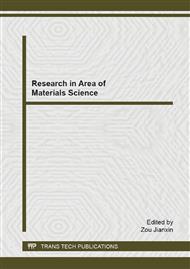[1]
S. B Chen, T. M Wang, Q. H Wang, Damping Properties of Polyurethane/Epoxy Graft Interpenetrating Polymer Network Composites Filled with Short Carbon Fiber and Nano-SiO2, J. Macromol. Sci. B. 50(2011)931-937.
DOI: 10.1080/00222348.2010.497068
Google Scholar
[2]
Ristić I.S., Simendić J.B., Krakovsky I., The properties of polyurethane hybrid materials based on castor oil, Mater. Chem. Phys. 132(2012)74-85.
DOI: 10.1016/j.matchemphys.2011.10.053
Google Scholar
[3]
Sperling L.H. Recent Advance in Interpenetrating Polymer Networks, Polym. Eng. Sci. 9(1985)517-521.
Google Scholar
[4]
Wang Q.H., Chen S.B., Wang T.M., Damping, thermal, and mechanical properties of polyurethane based on poly(tetramethylene glycol)/epoxy interpenetrating polymer networks: effects of composition and isocyanate index, Appl. Phys. A. 104(2011).
DOI: 10.1007/s00339-010-6153-7
Google Scholar
[5]
Hartmann B, Relation of Polymer Chemical Composition to Acoustic Damping, Polym. Mater. Sci. Eng. 60(1989)484-502.
Google Scholar
[6]
Yoon K.H., Kim J.G., Bang D.S., Damping Properties and Transmission Loss of Polyurethane. II. PU Layer and Copolymer Effect, Fiber Polym. 22(2003)49-61.
DOI: 10.1007/bf02875436
Google Scholar
[7]
Kostrzewa M., Hausnerova, B., Bakar, B., Property Evaluation and Structure Analysis of Polyurethane/Epoxy Graft Interpenetrating Polymer Networks, J. Appl. Polym. Sci. 122(2011), 1722-1740.
DOI: 10.1002/app.34070
Google Scholar
[8]
Qin C.L., Zhao D.Y., Bai X.D., Vibration damping properties of gradient polyurethane/vinyl ester resin interpenetrating polymer network, Mater. Chem. Phys. 97(2006) 517-533.
DOI: 10.1016/j.matchemphys.2005.10.022
Google Scholar
[9]
Hur, T., Manson J.A., Sperling L.H., Interplay of Rubber Network theory with the Damping Behavior of Crosslinked Polyurethanes, Polym. Mater. Sci. Eng. 61(1989)955-960.
DOI: 10.1002/polb.1989.090271108
Google Scholar
[10]
Chern Y.C., Hsien K.H., Ma C.C.M., Interpenetrating Polymer Networks of Polyurethane and Epoxy, J. Mater. Sci. 29(1994)5435-5449.
Google Scholar
[11]
Gnanarajan T.P., Iyer N.P. Nasar A.S., Preparation and properties of poly(urethane-imide)s derived from amine-blocked-polyurethane prepolymer and pyromellitic dianhydride, Eur. Polym J. 38(2002)489-502.
DOI: 10.1016/s0014-3057(01)00216-6
Google Scholar
[12]
Sperling L.H., Notes of the relationship between polymer glass transition characteristics and sound and vibration damping behavior, Polym. Eng. Sci. 60(1989)477-492.
Google Scholar
[13]
Qin C.L., Cai W.M., Cai J., Damping properties and morphology of polyurethane/vinyl ester resin interpenetrating polymer network, Mater. Chem. Phys. 85(2004)402-415.
DOI: 10.1016/j.matchemphys.2004.01.019
Google Scholar
[14]
Tsen W.C., Chuang F.S., Phase transition and domain morphology of siloxane containing hard-segmented polyurethane copolymers, J. Appl. Polym. Sci. 101(2006)4242-4262.
DOI: 10.1002/app.23087
Google Scholar


